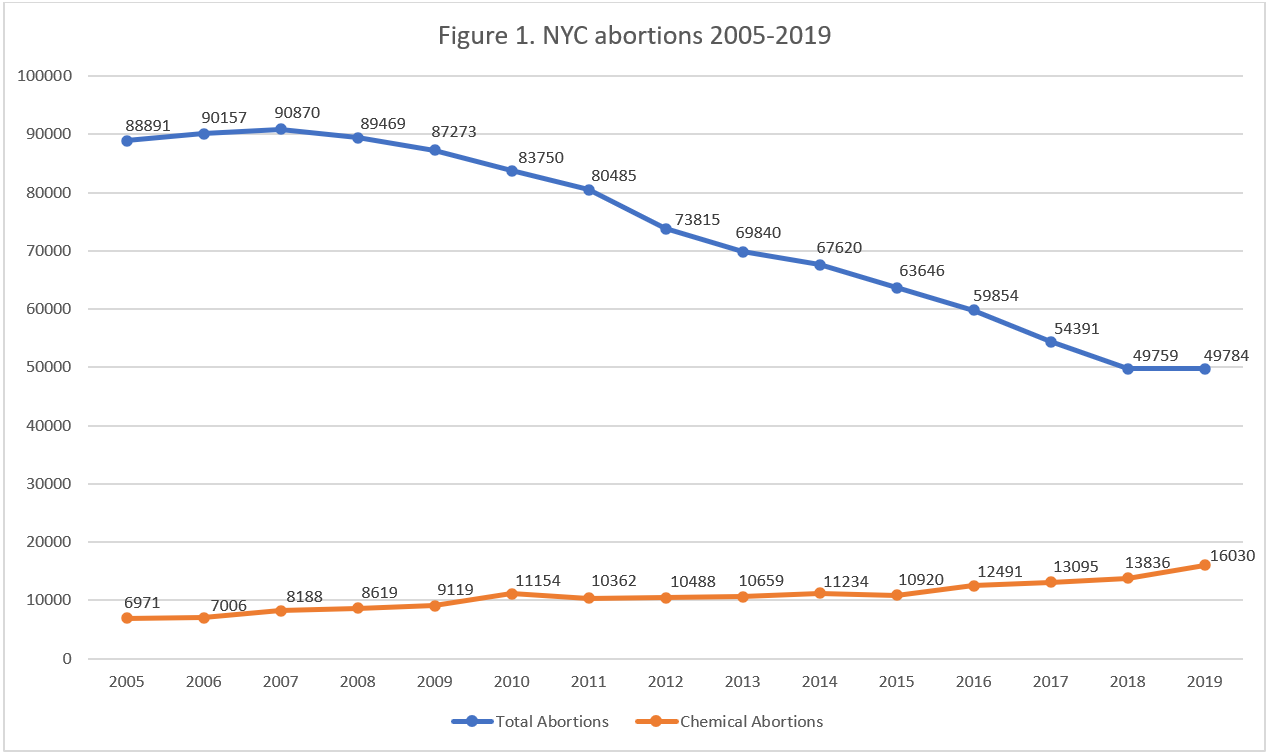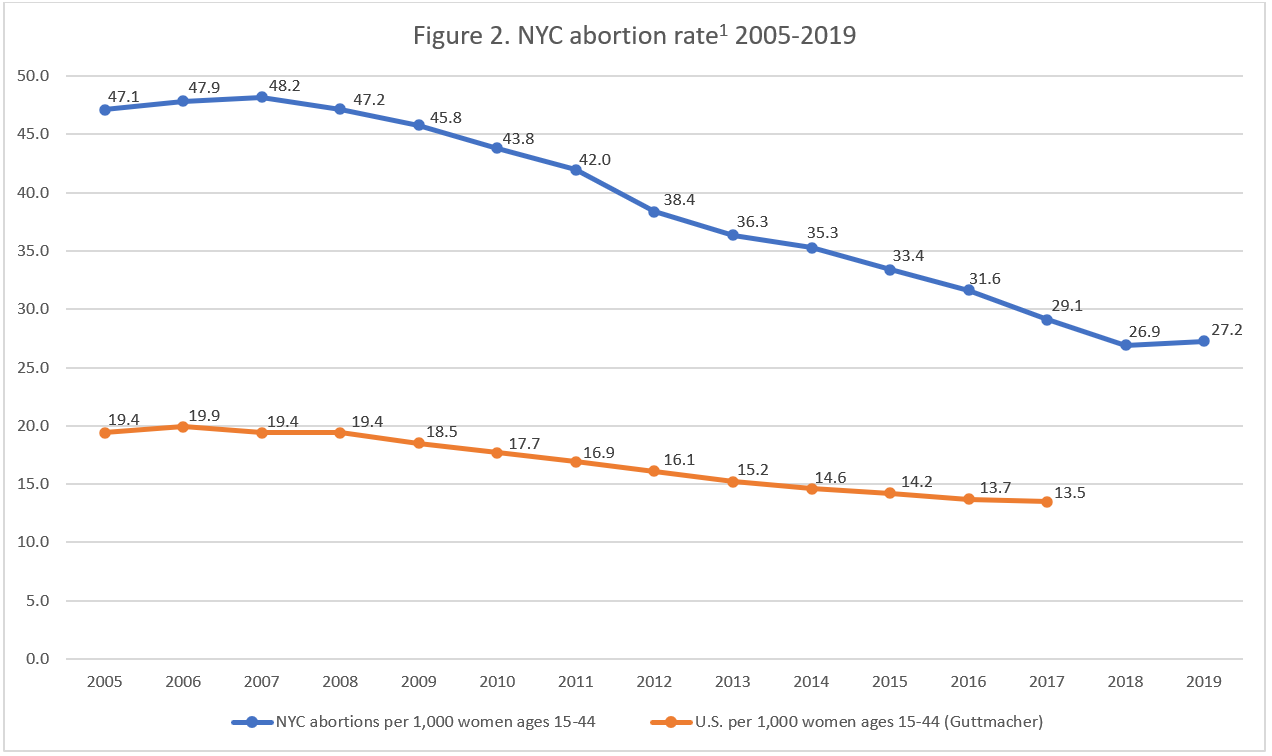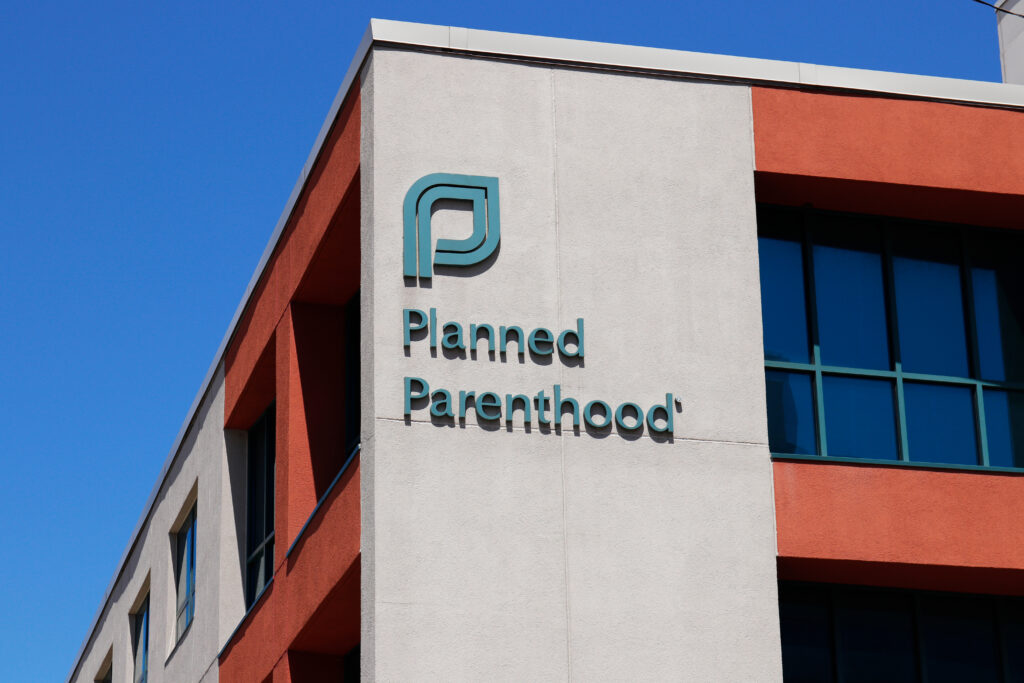Abortion Reporting: New York City (2019)
New York City’s 2019 abortion statistics were published online as part of the city’s vital statistics report in December 2021.
Changes in New York City Abortions, 2018-2019

The report does not include information on Planned Parenthood’s New York City abortion market share.
Abortion Totals and Trends
New York City released 2018 and 2019 abortion statistics in quick succession, showing that abortions declined in 2018 and held steady in 2019, with 49,784 abortions reported in the city in 2019 (Fig. 1). 2019 marked the first year in the decade that reported abortions did not decline. Chemical abortions compose a growing percentage of all New York City abortions, increasing by 16 percent in 2019 to make up 32 percent of the total, or 16,030 abortions. The Charlotte Lozier Institute (CLI) estimates that New York City’s 2019 abortion rate was 27.2 abortions per 1,000 women ages 15-44, approximately double the national rate (Fig. 2). Of the 48 reporting areas that shared 2018 and 2019 abortion statistics with the Centers for Disease Control, 25 reported that abortions increased in 2019.
State Report Summary
Ninety-one percent of New York City abortions were performed on city residents in 2019: 26 percent were on Brooklyn residents, 23 percent on women from Queens, 22 percent on residents of the Bronx, 17 percent on Manhattan women, and three percent on Staten Island residents. Nine percent of New York City abortions were performed on women who did not live in the city.
Eight percent of New York City abortions were obtained by girls under the age of 20, with five percent of total abortions on girls ages 18 and 19 and three percent on girls ages 17 and younger. A quarter of the abortions were performed on women ages 20 to 24, and 28 percent were on women ages 25 to 29. Twenty-one percent were obtained by women ages 30 to 34, and 13 percent were on women ages 35 to 39. Five percent were on women ages 40 and older.
Non-Hispanic black women are the racial group undergoing the largest percent of abortions in New York City in 2019, accounting for 35 percent of the total. Thirteen percent of the abortions were obtained by non-Hispanic white women, and 26 percent were performed on Hispanic women. Six percent were performed on Asian or Pacific Islander women, and four percent were on women of other races. Race was not reported for 15 percent of the abortions. CLI estimates that New York City’s non-Hispanic black abortion rate was 43.7 abortions per 1,000 women ages 15 to 44, four times the non-Hispanic white rate of 10.9. Seventy-three percent of New York City abortions were on unmarried women, and 17 percent were on married women, while marital status was not reported for 10 percent of the abortions.
A majority of New York City abortions (59 percent) were performed using suction curettage. Thirty-two percent were chemical, a smaller percentage than in most other reporting areas but an increase from 28 percent the previous year. Seven percent of the abortions were performed via dilation and evacuation, and two percent were sharp curettage or dilation and curettage abortions. There were 32 hysterectomy or hysterotomy abortions and 13 intrauterine instillation abortions, while 80 abortions were performed using some other unspecified method.
Forty-five percent of the abortions reported in New York City occurred at six weeks of gestation or earlier. Twenty-eight percent were performed between seven and eight weeks, and 11 percent were reported between nine and 10 weeks of gestation. Five percent occurred between 11 and 12 weeks, and four percent were reported from 13 to 15 weeks. Another four percent of New York City abortions were performed between 16 and 20 weeks of gestation. There were 1,096 abortions (over two percent of the total) reported at 21 weeks of gestation or later, higher than in many other reporting areas.
The largest portion of New York City abortions were performed in Manhattan (44 percent). Twenty-seven percent were performed in Queens, and 16 percent occurred in the Bronx. Thirteen percent of the abortions were performed in Brooklyn, while just one percent were performed on Staten Island.
Pregnancy Outcomes by Race
The state of New York requires comprehensive reporting of all pregnancy outcomes – live birth, induced abortion, and spontaneous abortion or miscarriage at any gestational age. New York City and New York State operate as two separate registration areas and share data with each other through a cooperative agreement. New York City’s vital statistics report contains the number of pregnancy outcomes occurring in the city to both residents and nonresidents and breaks these down by race, although New York State cautions that miscarriages are underreported, particularly those occurring at earlier gestational ages.
For each racial group, more reported pregnancies ended in birth than in induced abortion. In 2019, 13 percent of the non-Hispanic white pregnancies reported in New York City ended in abortion. Fourteen percent of Asian and Pacific Islander pregnancies were aborted, and 29 percent of Hispanic pregnancies ended in abortion. Forty-five percent of non-Hispanic black pregnancies ended in abortion.
However, the reported number of abortions undergone by each racial group is almost certainly lower than the actual total, because race was not reported for 15 percent of the abortions. Race was reported for all but 0.3 percent of the births. When totals are adjusted to account for this underreporting by distributing abortions and births of unknown race among the racial groups, there are more non-Hispanic black abortions (20,788) than births (20,114).
State Ranking
In 2016, CLI evaluated abortion reporting across the country, and New York City was ranked at 31st best. New York City and New York State require abortion providers to file certificates of induced termination of pregnancy that enable data collection for research. However, estimates from the Guttmacher Institute suggest that a significant number of New York abortions are not reported. New York City could improve its reporting by reminding all abortion providers of the reporting requirement. New York City and New York State could also ensure that abortion pills sent via the mail are reported to the city by reviewing their abortion reporting requirements to make sure they are applicable to all practitioners who prescribe abortion-inducing drugs to New York women, regardless of where the abortion provider is physically located.


- Rates were calculated by CLI using the following formula: (total number of abortions performed in New York City ÷ number of resident women ages 15-44) x 1,000. Rates may differ slightly from previous CLI articles due to revised population estimates. Population estimates were obtained from CDC WONDER.
Percentages may not add to 100% due to rounding.





















